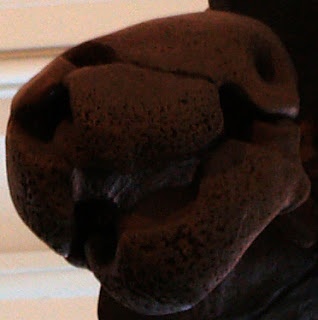Saturday, July 16, 2011
Picture of the Indiscriminate Interval #000005a - The Bulldog-Turtle
No time for a proper write-up, so here's a mysterious teaser. Can anyone identify the mystery skull?
Thursday, July 14, 2011
Picture of the Indiscriminate Interval #000004b - Megalocnus rodens
The unusual skull from the last article does not belong to some huge rodent, glyptodont, diprotodontid, or Thylacoleo - it is from the extinct Cuban sloth Megalocnus rodens. This particular specimen was part of a panoply of sloths at the American Museum of Natural History:
 |
| Megalocnus is in the foreground, with Megalonyx facing towards it, Scelidotherium facing away, and Lestodon rearing up in the background. |
 |
| Note the radically different skull of Scelidotherium - it is a mylodontid unlike the other two megalonychids. 'Ground Sloths' are far from a homogeneous group. |
The most striking aspect of Megalocnus rodens is the vaguely rodent-like skull, and it was in fact initially described as a giant rodent from an incomplete mandible (de Paula Couto 1967). While the chisel-like first teeth look particularly rodent-y, the overall dentition is similar to Megalonyx (de Paula Couto 1967). Compared with the other sloths on display, M. rodens displays an elongated neck, heavy body, short tail, and plantigrade hands and feet (de Paula Couto 1967). M. rodens may have been the second-smallest 'ground sloth' on display at the AMNH (Hapalops is slightly out of view), however it was still a large animal which may have weighed about 150 kg (330 lbs) in life (van der Geer et al. 2010). Not bad for a terrestrial Cuban mammal
Megalocnus rodens is most notable for when it went extinct - the latest fossil dates from 4200 years before present (MacPhee et al. 2007). These sloths were still trundling about when the Great Pyramid of Giza was hundreds of years old. All mainland sloths, except of course Bradypus and Choloepus, were extinct by about 10,000 years ago; in contrast, the Antilles had 13 species of sloths in the late Quaternary (Steadman et al. 2005). Most remarkable of all, M. rodens appears to have co-existed with humans on Cuba for over a millennium (MacPhee et al. 2007). There does not appear to be any clear evidence for how the sloths went extinct, although a 'long-fuse' model of human predation would appear to be the most likely. If only they held on for a few more millennia.
References:
Gaudin, T. J. (2004). Phylogenetic relationships among sloths (Mammalia, Xenarthra, Tardigrada): the craniodental evidence. Zoological Journal of the Linnean Society 140, 255–305. Available.
van der Geer, A., Lyras, G., de Vos, J., and Dermitzakis, M. (2010). Evolution of Island Mammals: Adaptation and Extinction of Placental Mammals on Islands. John Wiley and Sons. Partially Available.
MacPhee, R. D. E., Iturralde-Vinent, M. A., and Vazquez, O. J. (2007). Prehistoric Sloth Extinctions in Cuba: Implications of a New “Last” Appearance Date. Caribbean Journal of Science 43(1), 94-98. Available.
de Paula Couto, C. (1967). Pleistocene edentates of the West Indies. American Museum Novitates 2304: 1–55.
Steadman, D. W., Martin, P. S., MacPhee, R. D. E., Jull, A. J. T., McDonald, H. G., Woods, C. A., Iturralde-Vinent, M., and Hodgins, G. W. L. (2005). Asynchronous extinction of late Quaternary sloths on continents and islands. PNAS 102(33), 11763-11768. Available.
Tuesday, July 12, 2011
Picture of the Indiscriminate Interval #000004a - Not A Rodent
I'll try something new here - can anyone out there identify this skull? As the title hints, this is not a rodent...
Subscribe to:
Posts (Atom)

